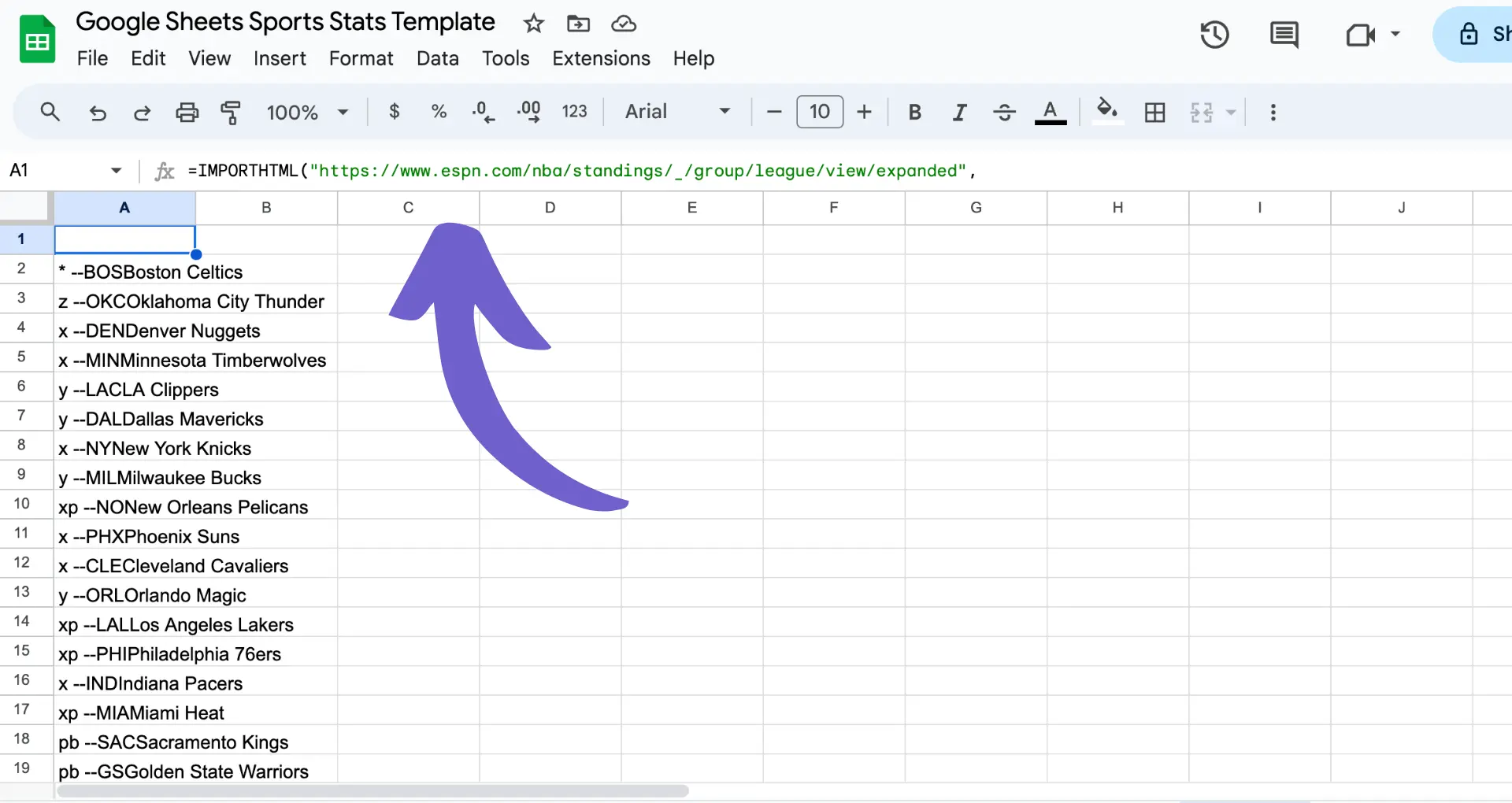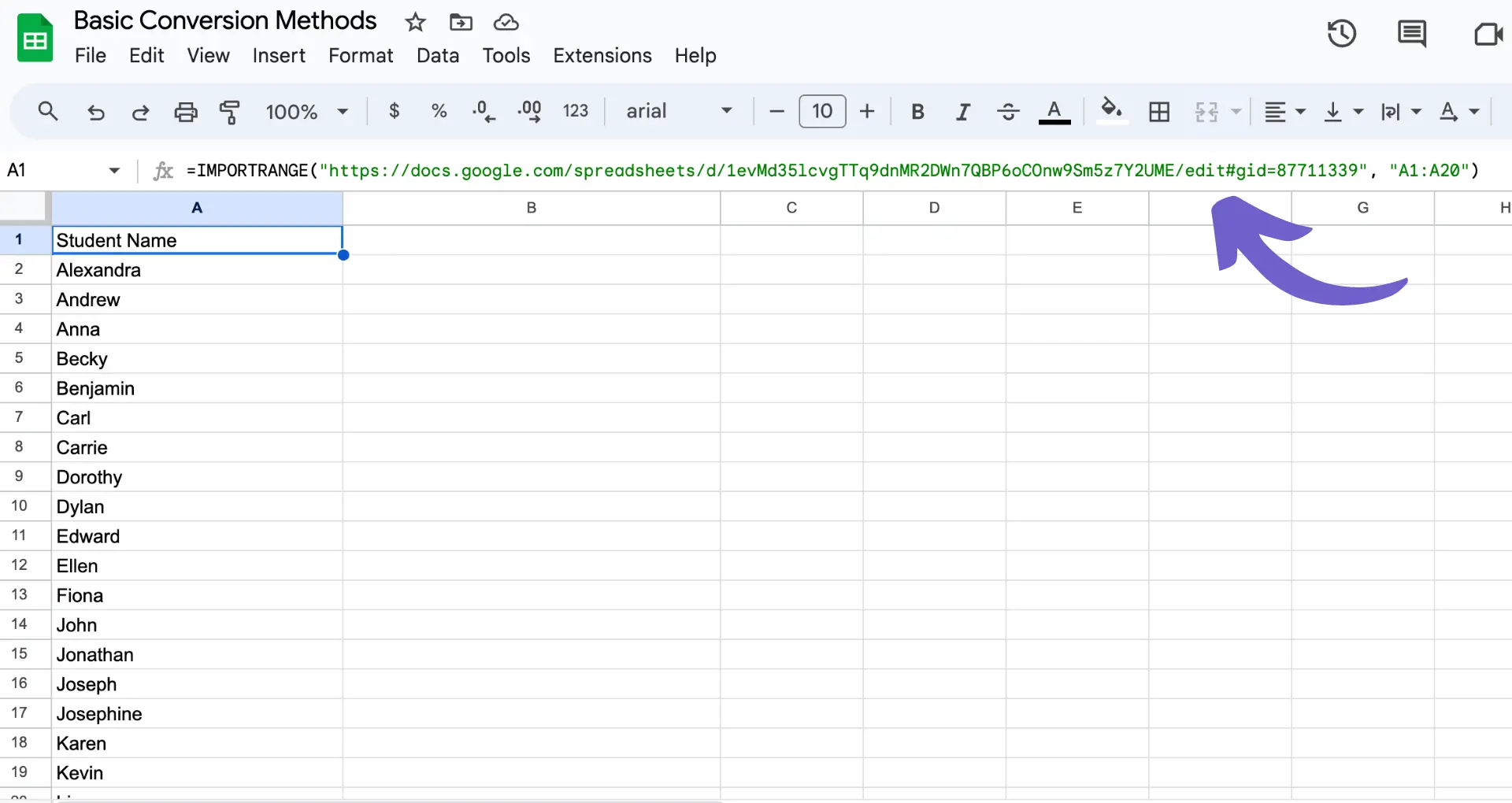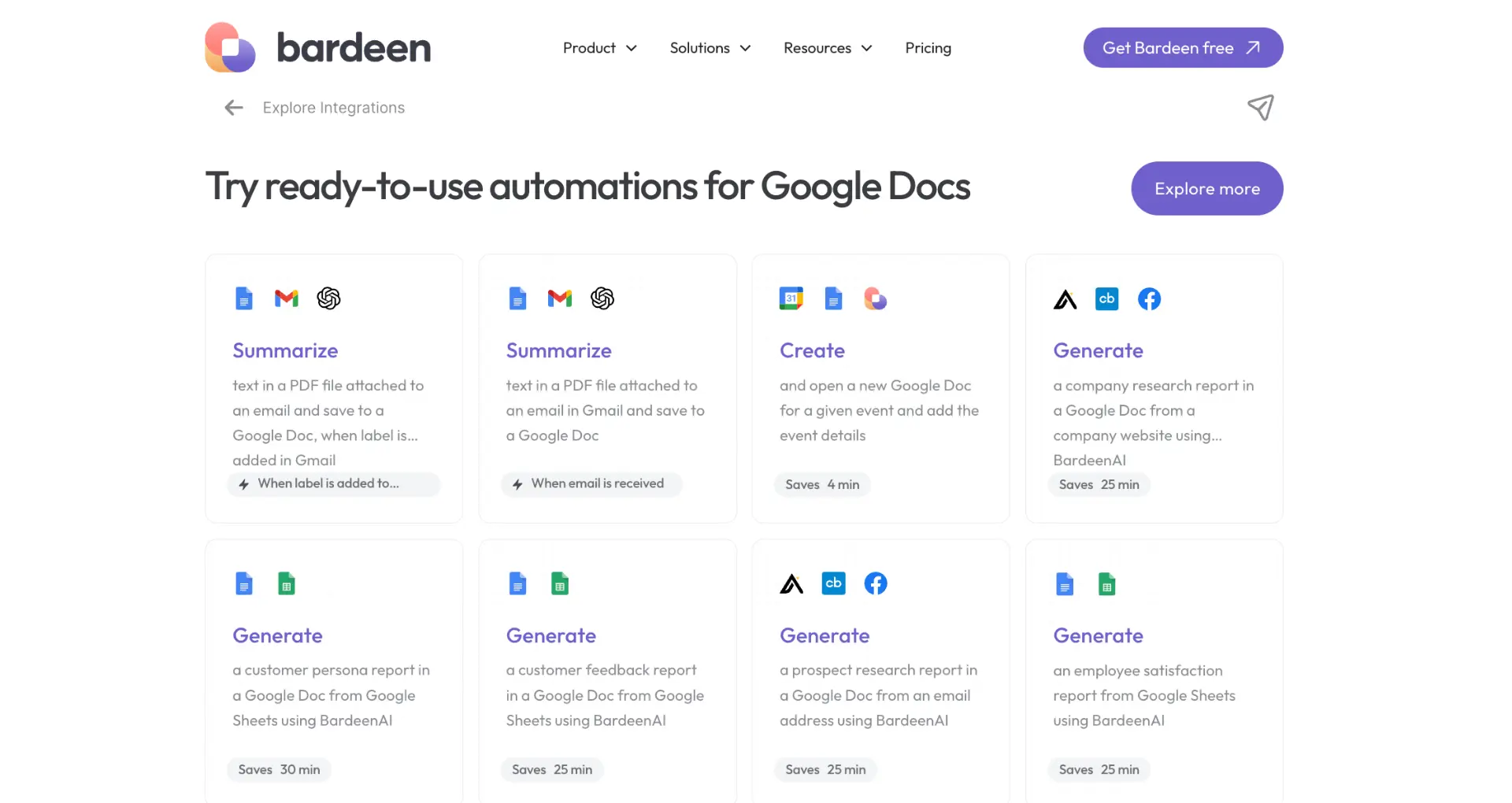Use IMPORTRANGE to bring data from one sheet to another.
By the way, we're Bardeen, we build a free AI Agent for doing repetitive tasks.
If you handle a lot of data, check out our GPT in Spreadsheets feature. It helps you import, format, and analyze data automatically.
Importing data from another sheet in Google Sheets is a crucial skill for efficiently managing and analyzing data. In this step-by-step guide, we'll walk you through the process of using functions like IMPORTRANGE and IMPORTDATA to seamlessly bring data from external sources into your Google Sheets. We'll also cover best practices and troubleshooting tips to help you master data import and streamline your workflow.
Understanding Google Sheets Data Import Functions
Google Sheets offers several powerful functions for importing data from various sources, streamlining data management and boosting workflow efficiency. The primary functions include:
- IMPORTRANGE: Imports data from a specified range in another Google Sheets spreadsheet.
- IMPORTDATA: Imports data from a CSV or TSV file hosted online.
- IMPORTHTML: Imports data from tables or lists within a webpage.

- IMPORTXML: Imports data from XML files using XPath queries.
- IMPORTFEED: Imports data from RSS or ATOM feeds.
Each function excels in specific scenarios:
- Use IMPORTRANGE when you need to connect Google Sheets files or reference data across sheets within the same file.
- IMPORTDATA is ideal for importing structured data from CSV or TSV files, making it easy to update your sheet with data from external sources.
- IMPORTHTML and IMPORTXML are handy for extracting data from webpages or XML files, respectively, allowing you to pull relevant information directly into your sheet.
- IMPORTFEED is perfect for adding dynamic content like news headlines or blog post summaries to your sheet, keeping it up-to-date with the latest information.
By leveraging these functions, you can bring AI into your spreadsheet, reduce manual data entry, and ensure your sheets always have the most current information. This not only saves time but also minimizes the risk of errors, enabling you to make data-driven decisions with confidence.
Using IMPORTRANGE to Import Data Between Google Sheets
The IMPORTRANGE function in Google Sheets allows you to import data from one Google Sheets spreadsheet to another. Here's a step-by-step guide on how to use it:
- Open the source Google Sheets spreadsheet containing the data you want to import.
- Locate the URL of the source spreadsheet in the address bar. Copy this URL.
- Open the destination Google Sheets spreadsheet where you want to import the data.
- In a cell where you want the imported data to appear, type the formula:
=IMPORTRANGE("spreadsheet_url","range_string") - Replace
spreadsheet_urlwith the URL you copied from the source spreadsheet, enclosed in quotation marks. - Replace
range_stringwith the sheet name and range of cells you want to import, in the format "Sheet1!A1:B10". If you want to import the entire sheet, simply use the sheet name, like "Sheet1". - Press Enter to complete the formula.

The first time you use IMPORTRANGE to connect two spreadsheets, you'll need to grant permission. A #REF! error will appear, prompting you to "Allow access". Click the "Allow access" button to establish the connection.
Common issues you may encounter include:
- Permission errors: Ensure you have the necessary access rights to both the source and destination spreadsheets.
- Delays: If the source spreadsheet is large or contains complex calculations, there may be a delay in importing the data. Be patient and wait for the import to complete.
- Incorrect range_string: Double-check that you've specified the correct sheet name and cell range in the range_string parameter.
To troubleshoot issues, check the spelling and formatting of your IMPORTRANGE formula, ensure you have the necessary permissions, and verify that the source spreadsheet and specified range are accessible. Also, consider using GPT for Google Sheets to enhance your productivity.
Save time on managing Google Sheets with Bardeen. Automate repetitive tasks like connect Microsoft Excel to speed up your spreadsheet workflows.
Harnessing IMPORTDATA for External Data Sources
The IMPORTDATA function in Google Sheets allows you to import data from external sources, such as CSV or TSV files available online. Here's a step-by-step guide on how to use it:
- Find the URL of the CSV or TSV file you want to import.
- Open your Google Sheets spreadsheet and select the cell where you want the imported data to appear.
- Type the formula
=IMPORTDATA("url"), replacing"url"with the actual URL of the file enclosed in quotation marks. - Press Enter to execute the formula and import the data.
For example, to import a CSV file located at https://example.com/data.csv, you would use the formula:
=IMPORTDATA("https://example.com/data.csv")
Keep in mind that IMPORTDATA has some limitations:
- The file size should not exceed 5MB.
- The imported data is not automatically updated. To refresh the data, you need to re-enter the formula or use a script to automate the process.
- The URL must be publicly accessible without requiring authentication.
To work around the data refresh issue, you can create a script that periodically re-imports the data using the IMPORTDATA function. This ensures that your spreadsheet always contains the most up-to-date information from the external source.
If you need advanced data handling, consider using automation tools for Google Sheets.
Advanced Techniques: Linking Sheets and External Data
Combining IMPORTDATA with other functions like QUERY can help you filter and manage imported data more effectively. Here's an example of how to use these functions together:
- Import the data using IMPORTDATA as shown in the previous section.
- Use the QUERY function to filter and manipulate the imported data. The syntax for QUERY is:
=QUERY(data, query, [headers])data: The range of cells containing the data to be queried, which in this case is the IMPORTDATA function.query: The query string that specifies the filtering and manipulation criteria.[headers]: (Optional) The number of header rows in the data range.
For example, to import data from a CSV file and filter it to only include rows where the value in column A is greater than 100, you would use:
=QUERY(IMPORTDATA("https://example.com/data.csv"), "SELECT * WHERE A \u003e 100", 1)To create dynamic reports that update automatically with external data changes:
- Set up your IMPORTDATA function to import the data from the external source.
- Use QUERY or other functions to filter and manipulate the data as needed.
- Create charts, tables, or other visualizations based on the imported and filtered data.
Scraping data from websites can also be integrated with Google Sheets to automate this process. When the external data source is updated, the IMPORTDATA function will automatically pull in the new data when the spreadsheet is refreshed or reopened. The QUERY function and any visualizations based on the imported data will also update accordingly, creating a dynamic report that stays up-to-date with the latest information.
Automate importing and updating data by using Bardeen's data enrichment tools to keep your Google Sheets dynamic and up-to-date with minimal effort.
Best Practices and Troubleshooting for Data Import in Google Sheets
When working with large imports and external data sources in Google Sheets, it's essential to follow best practices to maintain data integrity and ensure optimal performance. Here are some tips:
- Break large datasets into smaller, more manageable chunks to avoid hitting file size limits and improve processing speed.
- Regularly check the data in your source files to ensure consistency and accuracy before importing.
- Use data validation to restrict input and maintain data integrity.
- Optimize your spreadsheets by removing unnecessary formatting, formulas, and data.
If you encounter errors while importing data, here are some common issues and their solutions:
- #REF! error: This occurs when a formula references a cell that no longer exists. Update your formulas to reference the correct cells.
- #ERROR!: This can happen when a formula contains an error or when imported data is incompatible with the formula. Check your formulas and data for inconsistencies.
- Access issues: Ensure you have the necessary permissions to access the source file or URL. If using IMPORTRANGE, make sure to grant access to the source sheet.
- File size limits: If your import exceeds the file size limit, try splitting the data into multiple files or use an alternative import method like data enrichment tools.
- URL problems: Double-check that the URL is correct and accessible. If using IMPORTDATA, ensure the file is in the correct format (CSV or TSV) and hosted on a reliable server.
By following these best practices and troubleshooting steps, you can ensure smooth and efficient data imports in Google Sheets, allowing you to focus on analyzing and utilizing your data effectively. For enhanced data processing, consider integrating Google Docs with your spreadsheet workflow.

Automate Google Sheets with Bardeen: A New Era
Importing data from another sheet in Google Sheets can be a manual process of copying and pasting or using functions like IMPORTRANGE. However, for those looking to streamline their workflow and ensure data integrity, automating this process with Bardeen can be a game-changer. Automation can save time, reduce errors, and allow for real-time data updates across sheets.
Here are examples of automations you can build with Bardeen:
- Copy a newly created Asana task to Google Sheets: This playbook automates the process of copying new tasks from Asana directly into a Google Sheet, ensuring your task management and data tracking are seamlessly integrated.
- Copy records from SmartSuite to Google Sheets: Automate the transfer of records from SmartSuite into a Google Sheet for easy access and analysis, streamlining project management and reporting.
- Copy an Airtable to Google Sheets: This playbook simplifies the process of moving data from Airtable to Google Sheets, enabling efficient data consolidation and analysis.
To leverage these automations and more, start by downloading the Bardeen app at Bardeen.ai/download.





.svg)
.svg)
.svg)
